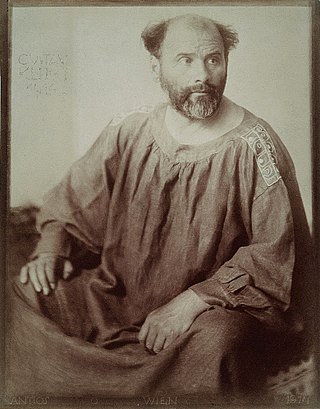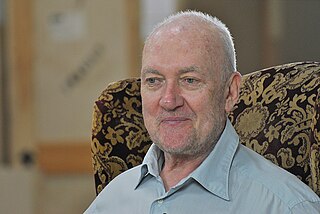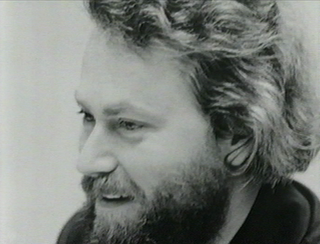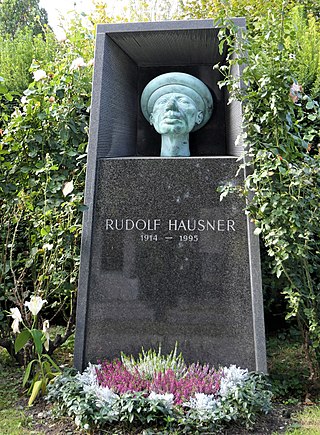
Gustav Klimt was an Austrian symbolist painter and one of the most prominent members of the Vienna Secession movement. Klimt is noted for his paintings, murals, sketches, and other objets d'art. Klimt's primary subject was the female body, and his works are marked by a frank eroticism. Amongst his figurative works, which include allegories and portraits, he painted landscapes. Among the artists of the Vienna Secession, Klimt was the most influenced by Japanese art and its methods.

Sean Scully is an Irish-born American-based artist working as a painter, printmaker, sculptor and photographer. His work is held in museum collections worldwide and he has twice been named a Turner Prize nominee. Moving from London to New York in 1975, Scully helped lead the transition from Minimalism to Emotional abstraction in painting, abandoning the reduced vocabulary of Minimalism in favour of a return to metaphor and spirituality in art.

Donald Clarence Judd was an American artist associated with minimalism. In his work, Judd sought autonomy and clarity for the constructed object and the space created by it, ultimately achieving a rigorously democratic presentation without compositional hierarchy. He is generally considered the leading international exponent of "minimalism", and its most important theoretician through such writings as "Specific Objects" (1964). Judd voiced his unorthodox perception of minimalism in Arts Yearbook 8, where he says, "The new three dimensional work doesn't constitute a movement, school, or style. The common aspects are too general and too little common to define a movement. The differences are greater than the similarities."

Ernst Haas was an Austrian-American photojournalist and color photographer. During his 40-year career Haas trod the line between photojournalism and art photography. In addition to his coverage of events around the globe after World War II Haas was an early innovator in color photography. His images were carried by magazines like Life and Vogue and, in 1962, were the subject of the first single-artist exhibition of color photography at New York's Museum of Modern Art. He served as president of the cooperative Magnum Photos. His book of volcano photographs, The Creation (1971), remains one of the most successful photography books ever published, selling more than 350,000 copies.

Ernst Fuchs was an Austrian painter, draftsman, printmaker, sculptor, architect, stage designer, composer, poet, and one of the founders of the Vienna School of Fantastic Realism. In 1972, he acquired the derelict Otto Wagner Villa in Hütteldorf, which he restored and transformed. The villa was inaugurated as the Ernst Fuchs Museum in 1988.

The Kunsthistorisches Museum Wien is an art museum in Vienna, Austria. Housed in its festive palatial building on the Vienna Ring Road, it is crowned with an octagonal dome. The term Kunsthistorisches Museum applies to both the institution and the main building. It is the largest art museum in the country and one of the most important museums worldwide.

The Neue Galerie New York is a museum of early twentieth-century German and Austrian art and design located in the William Starr Miller House at 86th Street and Fifth Avenue in New York City. Established in 2001, it is one of the most recent additions to New York City's famed Museum Mile, which runs from 83rd to 105th streets on Fifth Avenue in the Upper East Side of Manhattan.

Mihael Milunović is a Serbian and French painter. His work encompasses a wide range of artistic disciplines, from painting, drawing and photography through large-scale sculptures, installations, to sound, video and objects. His main interests focus on social and political issues. By decontextualizing everyday objects, symbols or situations, Milunović provokes unease in the observer, a blend of alienation and curiosity.

The Academy of Fine Arts Vienna is a public art school in Vienna, Austria.

Rudolf Hausner was an Austrian painter, draughtsman, printmaker and sculptor. Hausner has been described as a "psychic realist" and "the first psychoanalytical painter".
Amanda Sage is an American painter who has studied and worked in Vienna, Austria and Los Angeles, California. She trained and worked with Ernst and Michael Fuchs, a classical artist who taught her Mischtechnik. Through Fuchs she came to know other Visionary artists with whom she has worked, exhibited and co-founded the Academy of Visionary Art in Vienna and the Colorado Alliance for Visionary Art. Sage is a lecturer, teacher, and live artist with works in international galleries and museums.

Peter Gric, or Petr Gric, is an Austrian painter, drawer, and illustrator originally from the Czech Republic. Motifs of futuristic landscapes and architecture, biomechanical surrealism, and fantastic realism can be found in his work. Gric is a member of the art groups Libellule and Labyrinthe.

Soshana Afroyim was an Austrian painter of the Modernism period. Soshana was a full-time artist and traveled frequently, exhibiting her work internationally. During her journeys, she portrayed many well known personalities and her art developed in different directions. Her early period artwork was largely naturalistic in nature, showing landscapes and portraits. Later her style developed towards abstract art, strongly influenced by Asian calligraphy.
Oleg A. Korolev is Russian artist, known for his art influenced by Russian religion. His paintings have been exhibited in private and corporate art collections of Russia, Europe, North America, and Australia.

Joannis Avramidis was a contemporary Greek-Austrian painter and sculptor. He was born in Batumi, on the Black Sea, in the Adjarian Autonomous Soviet Socialist Republic, an Autonomous Republic of the former Soviet Union, to a family of Pontic Greeks, who had fled the repression of ethnic minorities in the Ottoman Empire in the turmoil leading up to the Greco-Turkish War.
Richard Ernst Artschwager was an American painter, illustrator and sculptor. His work has associations with Pop Art, Conceptual art and Minimalism.
Thomas Reinhold is an Austrian painter, one of the initiators of so-called “New Painting”.

Emil Fuchs was an Austrian–American sculptor, medallist, painter, and author who worked in Vienna, London and New York. He painted portraits of Queen Victoria and Edward VII and was fashionable among London high society in the early 20th century.
Galerie St. Etienne is a New York art gallery specializing in Austrian and German Expressionism, established in Vienna in 1939 by Otto Kallir. In 1923, Kallir founded the Neue Galerie in Vienna. Forced to leave Austria after the 1938 Nazi invasion, Kallir established his gallery in Paris as the Galerie St. Etienne, named after the Neue Galerie's location near Vienna's Cathedral of St. Stephen. In 1939, Kallir and his family left France for the United States, moving the Galerie St. Etienne to New York City. The gallery still exists, run by Otto Kallir's granddaughter Jane at 24 West 57th Street.













